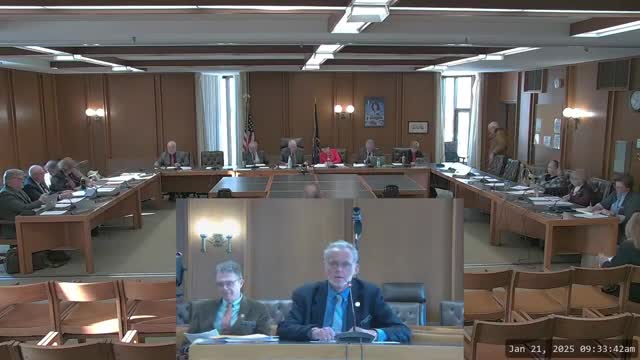New Hampshire lawmakers push for $60M school building aid to address $200M backlog
January 21, 2025 | Education, House of Representatives, Committees , Legislative, New Hampshire
This article was created by AI summarizing key points discussed. AI makes mistakes, so for full details and context, please refer to the video of the full meeting. Please report any errors so we can fix them. Report an error »

In a pivotal meeting of the New Hampshire House of Representatives Committee on Education Funding, lawmakers gathered to discuss the pressing issue of school building aid, a topic that has lingered in the shadows for over a decade. The atmosphere was charged with urgency as representatives voiced concerns over the deteriorating conditions of public school facilities across the state.
Representative Cahill, a frequent advocate for building aid, opened the discussion by highlighting the significant backlog of approximately $200 million in school building needs. He proposed increasing the annual funding cap from $50 million to a minimum of $60 million, emphasizing that this adjustment would allow future legislatures to allocate even more if circumstances permitted. "We can't keep kicking the can down the road," he urged, stressing the constitutional obligation to provide adequate educational facilities.
The committee heard testimonies from various representatives, including John Cloutier, who recounted the struggles of Claremont's Stevens High School, which narrowly lost a bond vote necessary for renovations. Cloutier's account underscored the financial strain on communities forced to shoulder the burden of school improvements without state support, leading to increased property taxes.
Superintendent Robert Thompson from Hampstead echoed these sentiments, detailing the urgent need for expansion due to rising enrollment and inadequate facilities. He pointed out that many special education students are currently educated in cramped, unsuitable spaces, further complicating the issue of equitable education.
The discussion also touched on the controversial topic of charter schools and their eligibility for building aid. Representative Mooney, who previously sponsored a bill allowing charter schools to apply for aid, defended the legislation as a necessary step toward equity in funding. However, concerns were raised about the potential diversion of limited resources from traditional public schools, which serve the majority of students.
As the meeting progressed, it became clear that the committee members were grappling with the complexities of funding distribution and the need for a fair system that addresses the needs of all schools, particularly those in property-poor communities. The urgency of the situation was palpable, with representatives acknowledging that without immediate action, many schools would continue to operate in substandard conditions, jeopardizing the education and safety of countless students.
In conclusion, the committee's deliberations highlighted a critical juncture for New Hampshire's education system. With a growing backlog of building needs and a pressing demand for equitable funding, the path forward remains uncertain. However, the commitment from lawmakers to address these challenges signals a potential turning point in the quest for better educational facilities across the state.
Representative Cahill, a frequent advocate for building aid, opened the discussion by highlighting the significant backlog of approximately $200 million in school building needs. He proposed increasing the annual funding cap from $50 million to a minimum of $60 million, emphasizing that this adjustment would allow future legislatures to allocate even more if circumstances permitted. "We can't keep kicking the can down the road," he urged, stressing the constitutional obligation to provide adequate educational facilities.
The committee heard testimonies from various representatives, including John Cloutier, who recounted the struggles of Claremont's Stevens High School, which narrowly lost a bond vote necessary for renovations. Cloutier's account underscored the financial strain on communities forced to shoulder the burden of school improvements without state support, leading to increased property taxes.
Superintendent Robert Thompson from Hampstead echoed these sentiments, detailing the urgent need for expansion due to rising enrollment and inadequate facilities. He pointed out that many special education students are currently educated in cramped, unsuitable spaces, further complicating the issue of equitable education.
The discussion also touched on the controversial topic of charter schools and their eligibility for building aid. Representative Mooney, who previously sponsored a bill allowing charter schools to apply for aid, defended the legislation as a necessary step toward equity in funding. However, concerns were raised about the potential diversion of limited resources from traditional public schools, which serve the majority of students.
As the meeting progressed, it became clear that the committee members were grappling with the complexities of funding distribution and the need for a fair system that addresses the needs of all schools, particularly those in property-poor communities. The urgency of the situation was palpable, with representatives acknowledging that without immediate action, many schools would continue to operate in substandard conditions, jeopardizing the education and safety of countless students.
In conclusion, the committee's deliberations highlighted a critical juncture for New Hampshire's education system. With a growing backlog of building needs and a pressing demand for equitable funding, the path forward remains uncertain. However, the commitment from lawmakers to address these challenges signals a potential turning point in the quest for better educational facilities across the state.
View full meeting
This article is based on a recent meeting—watch the full video and explore the complete transcript for deeper insights into the discussion.
View full meeting
